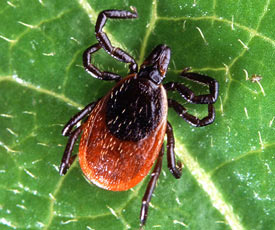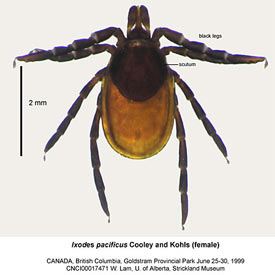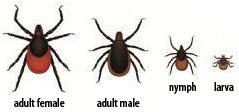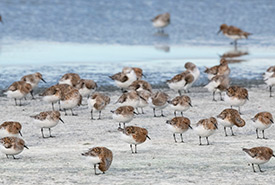Ick, it’s a tick! Tips for tick safety

Adult deer tick (Photo by Scott Bauer/Wikimedia Commons)
At the Nature Conservancy of Canada (NCC), field work is an integral part of many staffers’ routine, be it leading volunteer events or conducting various conservation activities. When it comes to spending time outdoors, it is important to be knowledgeable about and take precautions against critters that may pose a health risk.
One of the critters that has garnered media attention of late is the tick. Certain species of ticks transmit Lyme disease, and reports of Lyme-carrying ticks are spreading in Canada. Tick season typically starts mid-spring and can run until October in parts of Canada. Remember to watch out for these little free-loaders if you’re spending a lot of time outside or in the field, especially in areas known to have an abundance of ticks. Here are a few tick tactics to keep in mind when heading out into the field this season.
Know your environment
Be aware of areas where ticks live and thrive. If you’re hiking, try to walk in the centre of the trail. If you need to take a break, sit on a rock instead of on the ground.

Western blacklegged tick (Photo by W. Lam, U of Alberta, Strickland Museum)
Raise your protective barrier
Wear long-sleeved shirts and long pants to keep your skin protected from ticks. Cover your head with a hat, tucking in any long hair, and wear high boots if you have them. Ticks are usually found close to the ground, so tucking your pants into your socks or boots may provide extra protection. You should also make sure there aren’t any gaps in your clothing that ticks could get into. Wearing light-coloured clothing can help you can see ticks more easily and give you time to brush them off before they become attached to your skin.
Repel
Use insect repellent on clothing that may come in contact with grass and brush. Repellents that contain DEET are the most effective, but make sure you apply according to the directions.
Check yourself
After spending time in the field, do a thorough body check. Check your clothes for ticks before coming indoors. Inside, check your body for ticks; often you can find them before they have a chance to attach. Use a mirror to view all parts of your body, especially the following:
- Under the arms
- In and around the ears
- Inside the belly button
- Back of the knees
- In and around the hair
- Between the legs
- Around the waist
If possible, ask someone to check your head and back.
What to do if you get a tick (from the Alberta Health website):
Tick removal and preparation – Dos
- With tweezers, gently grasp its head and mouth parts as close to your skin as possible.
- Slowly pull the tick straight out. Do not jerk or twist it.
Tick removal and preparation – Don’ts
- Try not to squash it.
- Do not apply matches, cigarettes or petroleum jellies to the tick as these may cause an infected tick to release the bacteria into the wound.
Submit your tick to be tested for Lyme disease
The Canadian government encourages people to submit their ticks for testing to a public health laboratory, if possible. Note that tick identification and testing is not done in all provinces of Canada. (To find out where to submit a tick, visit the Canada Public Health Agency.)
To collect a tick for testing:
- Save the tick in a clean, empty pill bottle or double zip-lock bag. Do not add any ventilation holes. You can put more than one tick in the container if they are found on the same person or in the same general area in the environment.
- Add a small piece of tissue, lightly moistened with water, to keep the tick(s) alive.
- Call ahead to the health office or veterinarian to submit your tick.
Reminder: Please check your first aid kits to ensure they contain the materials listed above for tick removal and storage.

Deer tick (Photo by CanLyme)
Some facts on ticks and Lyme disease:
- Lyme disease is an infection that is spread by ticks. You can get Lyme disease if you are bitten by an infected tick. However, most people who have had a tick bite don’t get Lyme disease.
- Two types of ticks transmit the Lyme disease bacteria in Canada: deer ticks and western blacklegged ticks.
- Initial signs of Lyme disease are a round, red rash that spreads at the site of a tick bite. This rash can get very large. Flu-like symptoms are also common. People in the early stages of Lyme disease may feel very tired and have headaches, sore muscles and joints, and a fever.
- These symptoms can start at any time, from three days to up to a month after you have been bitten. Some people don’t have any symptoms when they are in the early stages of Lyme disease. They may not even remember getting a tick bite.
- Ticks are becoming more common in parts of the Atlantic provinces, southern B.C., Manitoba and Quebec.
Resources
Canadian Lyme Disease Foundation
Province of Prince Edward Island
Public Health Agency of Canada




